6 February 2018 marks 100 years since some UK women were granted the right to vote in parliamentary elections, after decades of campaigning.
The Representation of the People Act 1918 gave the right to vote to women over 30 who met a property qualification – 8.4 million women in total. With so many men having been killed in the First World War, there was a fear that if equal voting rights were given female votes would outnumber male voters, and the country would end up with a ‘petticoat parliament’.
(It’s also worth noting that before the Act, only 60% of men over 21 had the right to vote. This meant that many of the men returning from military service would not have been able to vote. In addition to granting the vote to women, the Act also extended it to all men over 21, an additional 5.4 million men.)
The campaign for votes for women had stretched over decades, and for most of that time made little progress. In this blog post we take a look at some of the local women and men who took part in this momentous national campaign.
Lilian and Amy Hicks – Great Holland
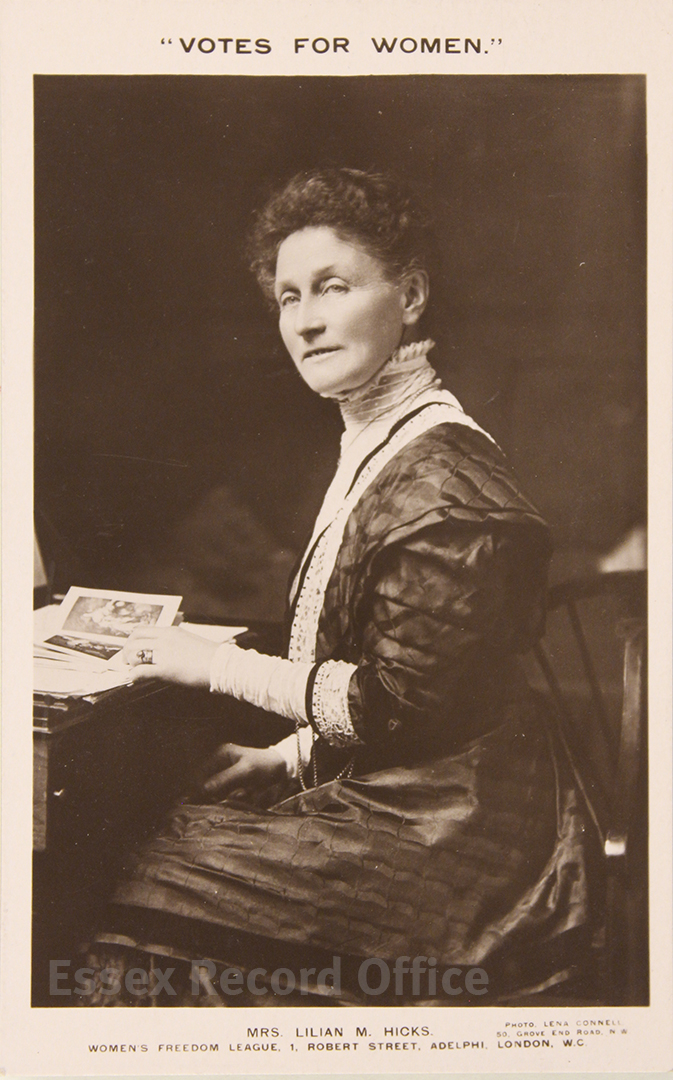
Photographic postcard of Lilian Hicks, produced by the Women’s Freedom League (D/DU 4041/1)
Lilian Hicks (née Smith) was born in Colchester in 1853. She married Charles Hicks, and they made their family home at Great Holland Hall near Frinton-on-Sea. From the 1880s, when she was the mother of young children, Lilian worked for the women’s suffrage movement, organising meetings across East Anglia, and when she was older her daughter Amy joined Lilian in her campaigning. They belonged to various suffrage organisations over the years, joining the militant WSPU in 1906 before breaking away with the more peaceful Women’s Freedom League (WFL) in 1907, then ultimately rejoining the WSPU. Mother and daughter were arrested together on 18 November 1910 at the protest which became known as Black Friday, a struggle between campaigners and police in Parliament Square which turned violent.
Amy took part in the WSPU window smashing campaign in March 1912, and was arrested and sentenced to four months hard labour. She spent time in Holloway and Aylesbury prisons, including time in solitary confinement. She was one of the suffrage prisoners who went on hunger strike, and was subjected to the brutal procedure of forcible feeding.
Read more about Lilian and Amy Hicks in our previous blog post about them
Dorothea and Madeleine Rock – Ingatestone
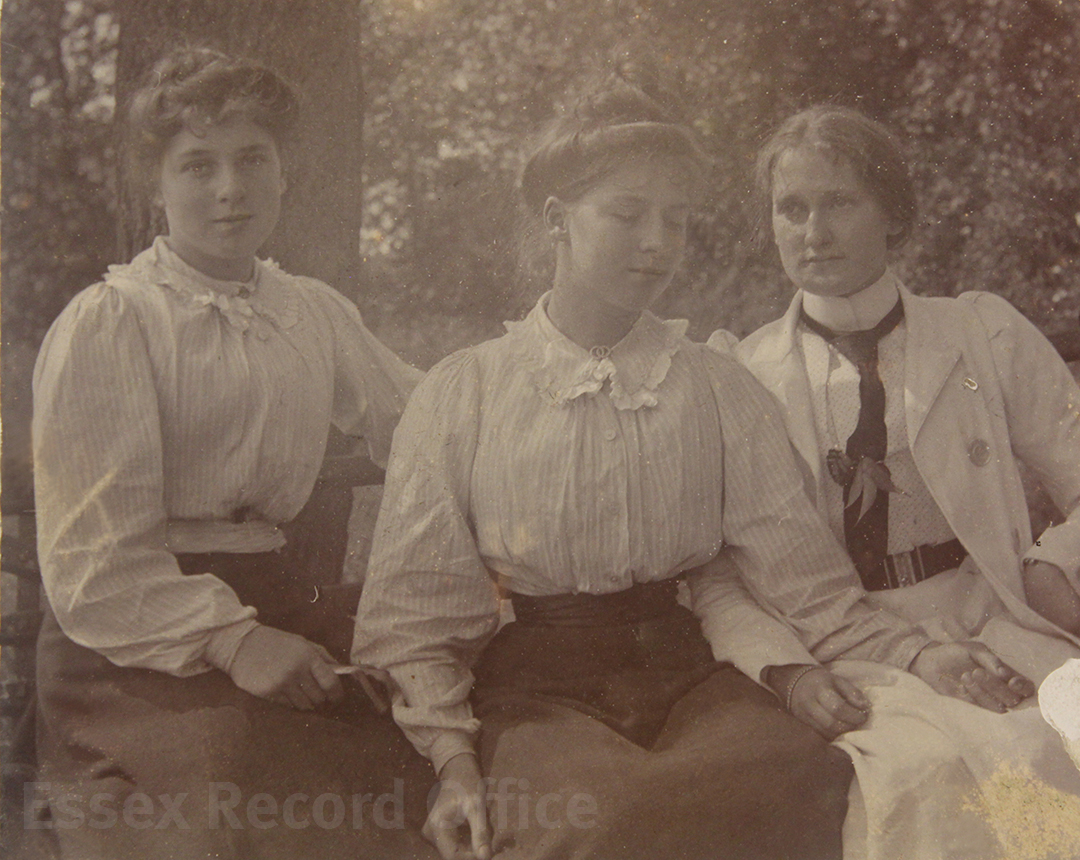
Sisters Dorothea and Madeline Rock of Ingatestone, left and centre. The caption on the back of the photograph does not tell us which sister is which, or the identity of the third woman, although she may be their governess, Louisa Watkins. This photograph has been digitally restored. (T/P 193/13)
Sisters Dorothea and Madeline Rock of Ingatestone both spent time in prison for their campaigning activities. They were daughters of Edward Rock, an East India tea merchant, and his wife Isabella. Dorothea was born in 1881 and Madeline in 1884, and they had a middle-class upbringing, with a governess, a cook, and a housemaid employed in the household.
In 1908, the sisters both joined the WSPU, and in December 1911 both were sentenced to 7 days’ imprisonment for smashing windows. Undeterred, the sisters smashed further windows in March 1912, and were arrested with fellow Suffragettes Grace Chappelow, from Hatfield Peverel, and Fanny Pease. The four attended a hearing together, which heard that they had smashed windows at London’s Mansion House with hammers and stones. A newspaper account of the hearing reported Dorothea defending their actions:
‘This thing is not done as wanton damage – we have done it as a protest against being deprived of the vote.’
Kate and Louise Lilley – Clacton
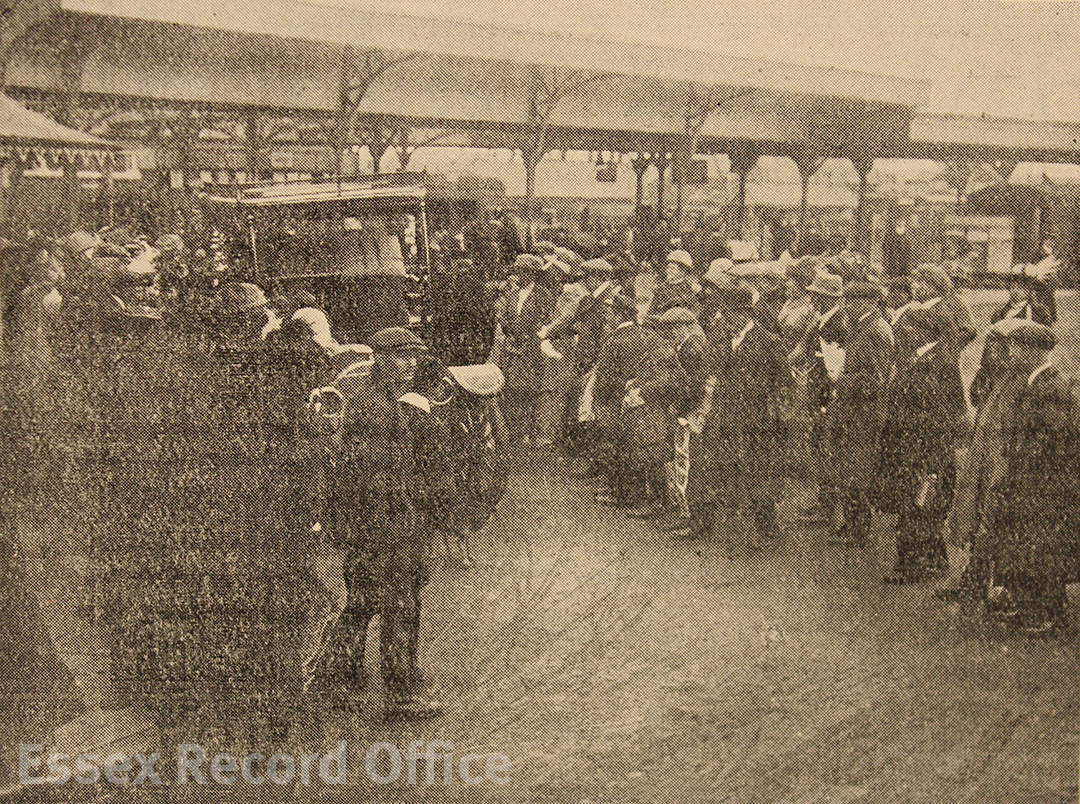
Kate and Louise Lilley are welcomed back to Clacton after being released from prison in May 1912. The pair were met at the station then driven home in their father’s motor car (Clacton Graphic, 4 May 1912, photo from Hoffman’s Studio)
Sisters Kate (b.1874) and Louise Lilley (b.1883) were daughters of Clacton magistrate and company director, Thomas Lilley JP. They were also both members and officials of the Clacton branch of the WSPU. Like the Rock sisters and Amy Hicks, they took part in the March 1912 WPSU window smashing campaign and were sentenced to two months’ hard labour as a result.
They were released in early May, and returning home to Clacton they were ‘met with a most hearty welcome home from hundreds of spectators, including many women wearing the W.S.P.U. badge’ (Clacton Graphic, 4 May 1912). The crowd cheered the sisters, and they were presented with bouquets. The Graphic further reported that ‘Their suffering for the cause, which they believe to be right and just, have not damped their ardour, and they are more determined than ever to go forward’.
Kate herself wrote a piece for the Graphic about their experience, and why the sisters had taken the course they had:
‘I should like to state that the reason why my sister and I decided to take our courage in both our hands, and make a protest by damaging property was: – we were following the dictates of our conscience and our reason. We know we had to make an active protest to call attention to the need of the great and urgent reform and so long delayed Act of Justice, i.e., Enfranchisement of Women.’
On the hunger strike which took place while they were in Holloway, Kate could only write:
the horrors of it are still too fresh in my memory for me to feel able to dwell in any way on the details.
Eliza Vaughan – Rayne
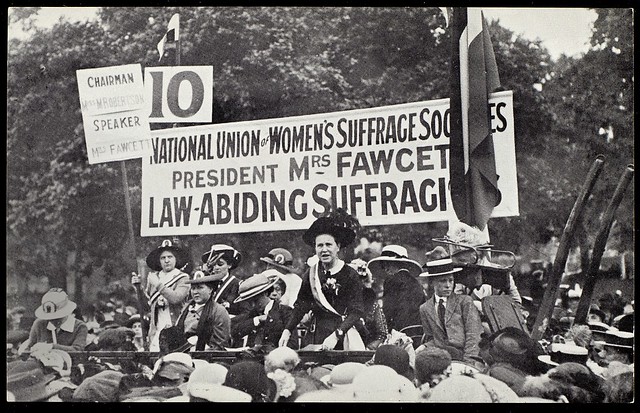
The NUWSS pilgrimage which Eliza Vaughan took park in in July 1913 ended with a rally in Hyde Park address by their leader, Millicent Garrett Fawcett (photo from the Women’s Library at LSE)
Eliza Vaughan was born in Brixton in 1863. Her father was a vicar, and later moved the family to Finchingfield when he became vicar there. From 1895 Eliza lived in Rayne near Braintree, and researched and wrote about the local area.
Eliza was an active member of the National Union for Women’s Suffrage Societies (NUWSS) for many years. Unlike the WSPU, the NUWSS believed firmly in sticking to peaceful campaigning activities.
In July 1913 Eliza took part in a march organised by the NUWSS which brought together suffrage campaigners from across the country, all the contingents eventually meeting for a rally in London. On 25 July 1913 a letter from Eliza was published in the Chelmsford Chronicle explaining why the march was taking place:
‘The just end of this gigantic undertaking is to demonstrate to the nation throughout the length and breadth of England the dertermination of non-militant suffragists to obtain justice for their own sex, so that the needs of women, particularly the toilers in our great industrial centres, may be adequately represented in Parliament.’
Eliza was one of the leaders of the Essex contingent, beginning in Colchester and marching through through several town and villages including Mark’s Tey, Coggeshall, Braintree, Witham, Kelvedon, Chelmsford and Romford. The marchers included both men and women, and in each place they stopped they made speeches, distributed leaflets and had conversations with people about women’s suffrage. Throughout the march they took pains to distance themselves from the militant actions of the Women’s Social and Political Union (WSPU) led by Emmeline Pankhurst. The audiences at the meetings are described by Eliza as being mostly orderly, but the marchers were in places subjected to abuse and egg-throwing.
In an account of the march titled ‘Humours of the Road’ (T/Z 11/27) Eliza describes the march as a pilgrimage ‘journeying to a shrine, dedicated to Justice and Right’.
Rosina Sky – Southend
Rosina Sky led the charge for votes for women in Southend. She was born in Whitechapel in 1877, the daughter of a Russian tobacconist and pipe manufacturer. She married William Sky, and they had three children together, before divorcing. As a single mother of three, Rosina ran a tobacconists shop of her own in Southend at 28 Clifftown Road. As a woman in a man’s world, Rosina had all the responsibilities of running a business with none of the rights accorded to men in the same position. She was treasurer of the Southend branch of the Women’s Social and Political Union (WSPU), and a member of the Tax Resistance League, whose slogan was ‘No Vote, No Tax’. Their key argument was that it was unjust for women to pay tax when without a vote they had no say in how it might be spent.
In September 1911, bailiffs seized goods belonging to Rosina in lieu of the taxes she had refused to pay. The goods were publicly auctioned, accompanied by a parade of the WSPU in Southend to protest. Further goods were confiscated from Rosina and sold in June 1912. She continued to run her shop until her death in 1922.
________________________________________________________________
A small display of records relating to Essex suffrage campaigners from the ERO’s collections is currently on display in our Searchroom, until the end of April 2018.

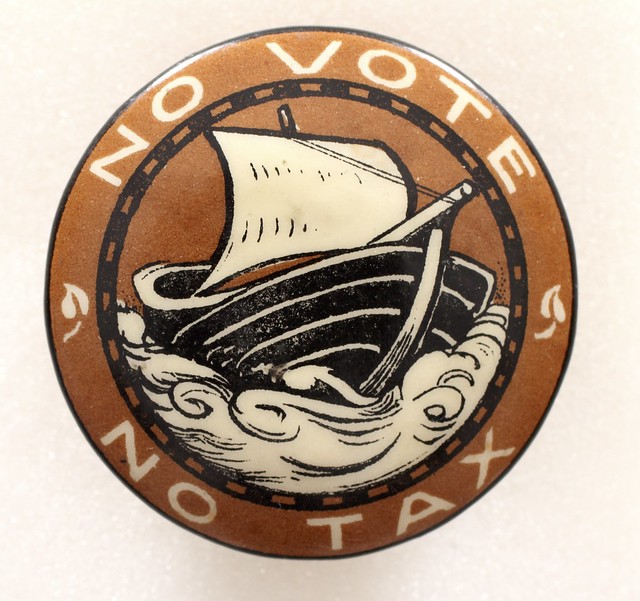
Very interesting! I wonder if you have anything on Jessie Mothersole?
Born in Colchester 1874, one of 5 daughters and one son to Thomas Mothersole, a wine merchant After a good schooling, she went to the Slade School of Art. She passed with honours and became a pupil of Henry Holland, glass and painter artist. He & his family were closely involved with the Pankhursts, and joined his support to the Movement In 1915, Jessie & Henry’s daughter attended the ‘International Congress of Women’ at The Hague. Jessie went on the write 4 books on Roman Britain, one on Czechoslavakia, and was also a proficient water colourist. In later life she became a ‘Practitioner’ in the Christian Science Movement.
Hi Richard, thanks for your comment, I’ve not come across Jessie Mothersole so far but I’ll add her to my list of interesting people to try to follow up…
Re: Jessie MOTHERSOLE
Thank you for your reply. Herewith a summary of her life:-
Jessie Mothersole 1874 – 1958 Author and Watercolourist
Jessie Mothersole was the author of four books on aspects of Roman Britain; ‘Hadrian’s Wall’ (1922), ‘The Saxon Shore’ (1924), ‘Agricola’s Road into Scotland’ (1927), and ‘In Roman Scotland’ (1927). All were researched, written, and illustrated with her own water colours, based on her extensive travels around the country, and published by Bodley Head. Apart from a small number of books on non-Roman subjects, her writing career appears to have ended by 1930. No photographs of her have appeared in the public domain, and no biography of her life is known. Given the significance of her Roman books, in content, in illustration, and as an informed snapshot of the state of knowledge of the subject at the time, it has proved interesting to bring together the few facts about her life.
Jessie was born in Colchester in 1874, the sixth child and fifth daughter of Thomas and Esther Mothersole. Her father was a wine merchant, and died in 1878 at the early age of 50. However, Esther carried on the business, and was still in a position to employ a cook and housemaid in the 1881 census. She died in 1912.
The only son, Robert, became a surgeon, married, but died childless in 1950.
Kate, the next youngest daughter to Jessie became a Church missionary but died in Yezd in what was then Persia in 1907. None of the daughters married.
Initially, Jessie went to school in Colchester, and in 1888, was awarded a special prize for distinction in French and drawing. After the family moved to Willesden, she went to the North London Collegiate School, and matriculated with honours in the University of London examination on July 16th 1891. Further success came in June 1894 when she was awarded a scholarship to the Slade school of Art, University College, London.
Here, she and a group of fellow students became involved, not only with the Suffragette Movement, but also with the work of the archaeologist Flinders Petrie. Jessie was with his expeditions to Egypt in 1903 / 1904 drawing the mainly relief sculptures being excavated.
In 1910, she published her first book, ‘The Isles of Scilly’ an illustrated description of ‘Their Story, their folk, and their flowers’, published by The Religious Tract Society.
Jessie became a pupil of Henry Holiday, and was heiress apparent to his studio.
A full-page cartoon by Holiday pleading for female emancipation contained a poem by Jessie, who, like him, was a suffrage advocate. Jessie became a keen supporter of the rights and votes for women campaign, and although she kept company with a number of publicly designated Suffragettes, does not appear to have been in trouble with the law. The National Archives holds a copy of her drawing of Myra Sadd Brown done at a meeting in 1912. Still involved, she appeared on a list of British delegates at the ‘International Congress of Women, held at The Hague in April 1915.
After the Great War, she exhibited her paintings at both the Walker Gallery
in 1922, and the Arlington Gallery in Old Bond Street in 1925. It was during the 1920’s, that she travelled around Britain, researching and having her four books on Roman Britain published. Between these, she travelled widely throughout Czechoslovakia – then a newly created country – and the resulting book was published as ‘Czechoslovakia – Land of an Unconquerable Ideal’.
This was despite suffering from a number of recurring ailments, which led her in 1924 to join the First Church of Christ, Scientist. She found the teaching of great comfort, and in 1928 became a recognised ‘Practitioner’, helping others.
She made two trips to America, probably to the Christian Science HQ at Boston, firstly. on the ‘Franconia’ in September/October 1930, and secondly, on the ‘Laconia’ in August /September 1937. On both occasion, she appeared on the passenger list as ‘Christian Science Practitioner’. There are no further references to her in the public domain, apart from in telephone directories and electoral registers, but she continued as a Practitioner until she retired in 1954. She died on the 22nd April 1958, leaving no close relatives, and her estate, valued at £4933.2s.8d, was administered by the Public Trustee. Apart from a few small legacies, the bulk of her estate was left to the Eleventh Church of Christ, Scientist, London. She was cremated at Beckenham Crematorium on Friday 25th April 1958.
One who knew her in later life described her as a small neat lady, with blue-grey eyes, and a lovely calm and pleasant presence. It is, perhaps, difficult to imagine her walking and cycling around the Roman sites, usually on her own, and often in inclement weather. Her books are a mixture of travelogue, and informed history and description, enlivened by her appreciation of humour and artist’s vision. She described Porchester (sic) as “famous for just two things, its castle and its wealth of hardy flowers”……”every house has its tempting little display of flowers for sale”. This was followed a few pages later by an in-depth description of the walls and bastions.
Her books had been long out of print, but are often found second-hand, and have now been re-issued as paperback copies. They are both a snapshot of the sites as they were in the 1920’s and a delight to read. In ‘Hadrian’s Wall’ she writes that “I am not an archaeologist; I am only an artist with a taste for archaeology”, but her books of travel around Roman Britain have never been entirely superseded.
Publications
1903. Apuleius. The Story of Cupid and Pyche. Stuttaford, C. (ed.) & JM (illustrated)
1905. Murray, M.A. Saqqara Mastabas Part 1. London. Bernard Quaritch.
(JM provided some of the illustrations).
1910. The Isles of Scilly – their story, their folk, their flowers. London.
The Religious Tract Society.
1922. Hadrian’s Wall. London. Bodley Head.
1924. The Saxon Shore. London. Bodley Head.
1926. Czechoslovakia – Land of an Unconquerable Ideal. New York.
Dodd, Mead & Co.
1927. Agricola’s Road into Scotland. London. Bodley Head
1927. In Roman Scotland. London. Bodley Head.
Acknowledgements:
The Flinders Petrie Museum, UCL
The Church of Christ Scientist, London
A lady who was comforted by Jessie
I have copies of some of her watercolours, but there doesn’t to be a facility with this system to provide attachments
regards
Interesting site.
I know of another Essex woman who campaigned for women’s rights.
Myra Sadd-Brown (nee Sadd b 1872) in Maldon Essex where her family where her family were timber merchants.
Member of WSPU, arrested 1912?, imprisoned in Holloway, went on hunger strike & force fed. Her medal now in an Australian museum!
An Internationalist, she was later involved with meeting which resulted in the formation of the British Commonweath League. She travelled all over the world promoting women’s rights. Had a huge book collection with which the BCL eatablished The Sadd-Brown Library which later helped form the basis of the Women’s Library.
I only know of her because her sister, Jessie Laura Sadd married a distant relative of mine, and as Jessie Girling* she too was arrested in a ‘Votes for Women’ demonstration alongside her sister Myra.
*3 siblings of the Sadd family married 3 siblings of the Girling family (Ipswich)
Thanks Linda, Myra is on my list of interesting people to hopefully investigate more at some point – sounds like there will be lots to find out!
Hi Linda………….you may know about this archive, but just in case you don’t…
Papers re Myra Sadd Brown
The entire contents of this catalogue are shown below. Browse the hierarchical structure instead
Reference 7MSB
Former reference 7/XX22; 7/XXX22
Covering dates 1912-1938
Held by London Metropolitan University, The Women’s Library
Extent 0.25 A box (1 folder)
Conditions of access This collection is available for research. Readers are advised to contact The Women’s Library in advance of their first visit.
Archival history The letters (donated in 1988) were previously referred to as ‘Papers of Myra Stedman’. The photographs were donated in 2007.
Source of acquisition Donated by Lady Diana Dollery in 1988 and 2007.
Creators Dollery, Lady Diana, fl 1988
best wishes